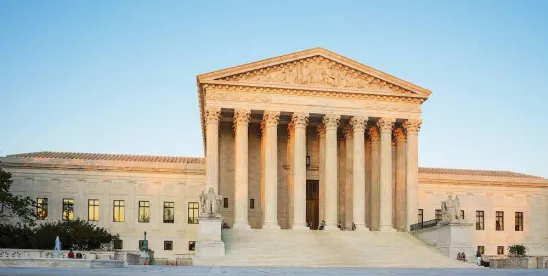Once again, the U.S. Supreme Court handed down three decisions on a Thursday, each of them substantively important to the individuals involved, but all of them essentially involving the Supreme Court’s instructing lower courts on how to go about interpreting both statutory mandates and caselaw precedents.
Two of the three decisions are unanimous. The third, involving capital punishment, predictably shows a 6–3 split between Court conservatives and liberals.
Of the three cases decided today, the Court’s unanimous decision in Cantero v. Bank of America is likely the one of greatest import to our audience of litigators because it involves the issue of determining federal preemption. Writing for the entire Court, Justice Kavanaugh begins by noting that banks with federal charters, i.e., “national banks,” are primarily subject to federal oversight and regulation, while state-chartered banks are subject to further state oversight and regulation. A federal law, the National Bank Act, especially grants national banks the power to administer home mortgage loans. While the home mortgage loans made by national banks often include escrow accounts that are extensively regulated under the federal Real Estate Settlement Procedures Act of 1974, there is no requirement for national banks to pay interest on escrow balances. New York State law, however, mandates that a lending bank “shall” pay borrowers such interest. In the instant case, several mortgage borrowers brought class action suits against a national bank, demanding payment of interest on their escrow accounts. The U.S. Court of Appeals for the Second Circuit held that because the New York law “would exert control over” national banks’ power “to create and fund escrow accounts,” the state’s law was preempted by the National Bank Act.
Vacating and remanding the case, the unanimous Court held that the Second Circuit failed to analyze whether New York’s interest-on-escrow law is preempted as applied to national banks in a manner consistent with the Dodd-Frank Wall Street Reform and Consumer Protection Act of 2010 and the Court’s decision in Barnett Bank of Marion Cty., N. A. v. Nelson, 517 U. S. 25 (1996). In Dodd-Frank, Congress ruled out “field preemption” and provided that the National Bank Act will preempt state law “only if” the state law discriminates against national banks or “prevents or significantly interferes with the exercise by the national bank of its powers,” as determined “in accordance with the legal standard for preemption” described in the Court’s decision in Barnett Bank. The New York law does not discriminate against national banks, so the issue is whether it “prevents or significantly interferes” with the powers of a national bank “in accordance with” Barnett Bank. That case, however, did not establish a bright-line test to determine “significant interfer[ence].” Instead, it requires trial courts to examine prior cases where state law was, or was not, preempted. The Supreme Court’s instant opinion rehearses a number of such cases and holds that, in this case, the Second Circuit did not conduct the required “nuanced comparative analysis” but instead erroneously created a “categorical test that would preempt virtually all state laws that regulate national banks.” Congress expressly incorporated Barnett Bank into Dodd-Frank, and, as a result, the Court of Appeals must conduct a preemption analysis in a manner consistent with that standard. Hence, the remand.
One might ask why, in such a specialized case involving a specific congressional mandate applicable to banking and the application of an industry-specific precedent, this writer is providing such a lengthy description of the Court’s holding. The answer is that both the Supreme Court and the courts of appeals are frequently called upon to resolve division-of-powers preemption claims, e.g., in retirement and health care-related laws. In analyzing preemption defenses in such cases, it is entirely worth noting the rigorous application of textual analysis and precedent that the Supreme Court has conducted in Cantero and pursuing what is rarely an easy categorical approach in any such case.
It might surprise some readers that a case upholding a constitutional claim of the National Rifle Association (NRA) would be unanimous. However, National Rifle Association of America v. Vullo is just that, and the reason for unanimity is not surprising. The NRA sued Maria Vullo, who had been the superintendent of the New York Department of Financial Services (DFS), alleging that she had violated the First Amendment by coercing regulated parties to punish or suppress the NRA’s firearms advocacy under the guise of dealing with the NRA’s allegedly fraudulent liability insurance policies. The Second Circuit held that Vullo’s actions constituted permissible government speech and legitimate law enforcement. The standard of review is a familiar one, more often than not, cited by those moving to dismiss cases: Ashcroft v. Iqbal, 556 U.S. 692 (2009), which held that a plaintiff must present a “plausible” cause of action. And while that case held in favor of senior government officials, Vullo was not so fortunate, at least for now.
Reversing the Second Circuit in a unanimous opinion written by Justice Sotomayor (Justices Gorsuch and Jackson also separately concurred), the Supreme Court held that the NRA plausibly alleged that Vullo had violated the First Amendment by coercing regulated entities to terminate their business relationships with the NRA in order to punish or suppress gun-promotion advocacy. Reiterating earlier holdings, the Court described the difference between the permissible case, where a government official pursues a course of action and expresses a particular viewpoint while rejecting others—one where viewpoint neutrality is unnecessary—and the impermissible case, where a government official uses her office to punish or suppress disfavored expression. Thus, a government official may not employ “the threat of invoking legal sanctions and other means of coercion . . . to achieve the suppression” of disfavored speech. To state a valid such claim, a plaintiff must plausibly allege conduct that, viewed in context, could be reasonably understood to convey a threat of adverse government action in order to punish or suppress speech. See Bantam Books, Inc. v. Sullivan, 372 U.S. 58 (1963). The fact that the NRA’s insurance policies were legally deficient is irrelevant. They were no more than the gateway to the state’s selective effort at suppression. Here, the Court held that the NRA plausibly alleged that Vullo violated the First Amendment by coercing DFS-regulated entities into disassociating with the NRA in order to punish or suppress the NRA’s gun-promotion advocacy. Accordingly, the Second Circuit, which had applied a mistaken analysis, suffered its second reversal and remand of the day.
Thornell v. Jones is yet another in the line of ineffective assistance of counsel claims that the Court has dealt with over the years. Especially since this case involves capital punishment, the alignment of Justices rejecting the claim is predictable, with Justice Alito writing for himself and the other five conservatives and Justices Sotomayor, Kagan, and Jackson dissenting. It is equally predictable that the conservative majority would describe in great detail the horrific conduct of the convicted murderer who was the respondent. In sentencing Danny Lee Jones to death, the trial court found that the various mitigating circumstances presented did not outweigh the aggravating circumstances presented. In the instant case, Jones argued that his trial counsel had failed to present certain expert and other testimony. To succeed on a claim of ineffective assistance of counsel, Jones needed to show that his counsel provided a “deficient” performance that “prejudiced” him. Strickland v Washington, 466 U. S. 668 (1984). Jones could have shown prejudice only if “there is a reasonable probability that, absent [counsel’s] errors, the sentencer . . . would have concluded that the balance of aggravating and mitigating circumstances did not warrant death.” “A reasonable probability is a probability sufficient to undermine confidence in the outcome. That requires a substantial, not just conceivable, likelihood of a different result.” In reversing the Ninth Circuit. The Supreme Court held that the appellate course had made three errors: failing to take adequate account of aggravating circumstance, applying a “strange” rule preventing the assessment of the strength of expert testimony, and finding trial court error in attaching diminished persuasive value to Jones’s mental health conditions. The essence of the majority opinion is what it held to be the Ninth Circuit’s having “all but ignored the strong aggravating circumstances in this case,” and its belief that a habeas petitioner is entitled to relief whenever he or she “presents substantial evidence of the kind that a reasonable sentencer might deem relevant to the defendant’s moral culpability.” Strickland holds otherwise, requiring a defendant to meet the more stringent showing of a “reasonable probability” of a different result. Where, as here, aggravating factors greatly outweigh mitigating evidence, the “reasonable probability” threshold is a problematic one.
Whatever one thinks about capital punishment or ineffective assistance claims, or of the result in this case, it breaks no new ground. If there is anything that should grab our attention, it is, I respectfully suggest, that Jones’s crimes took place 32 years ago.




 />i
/>i

